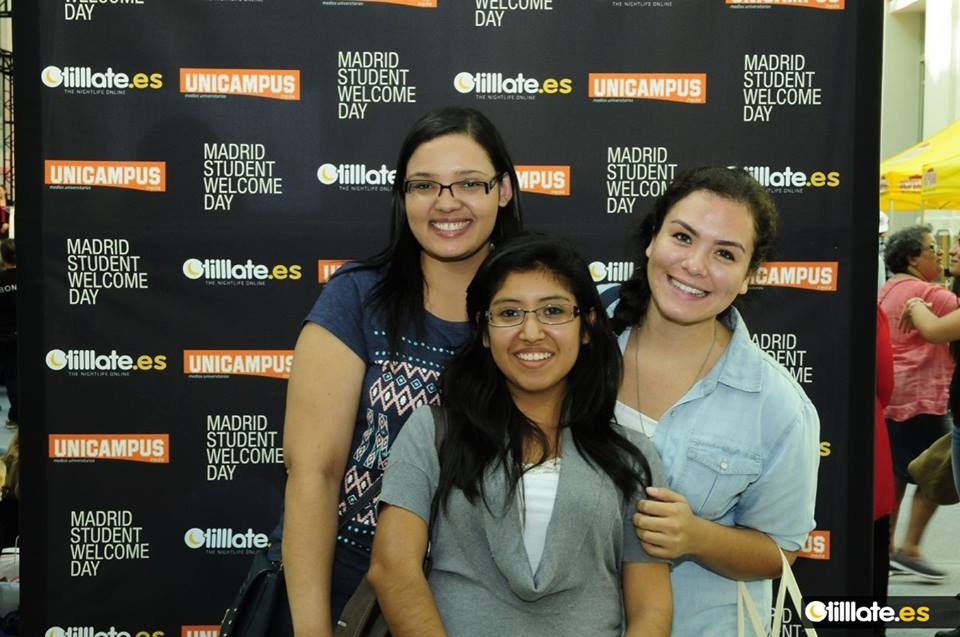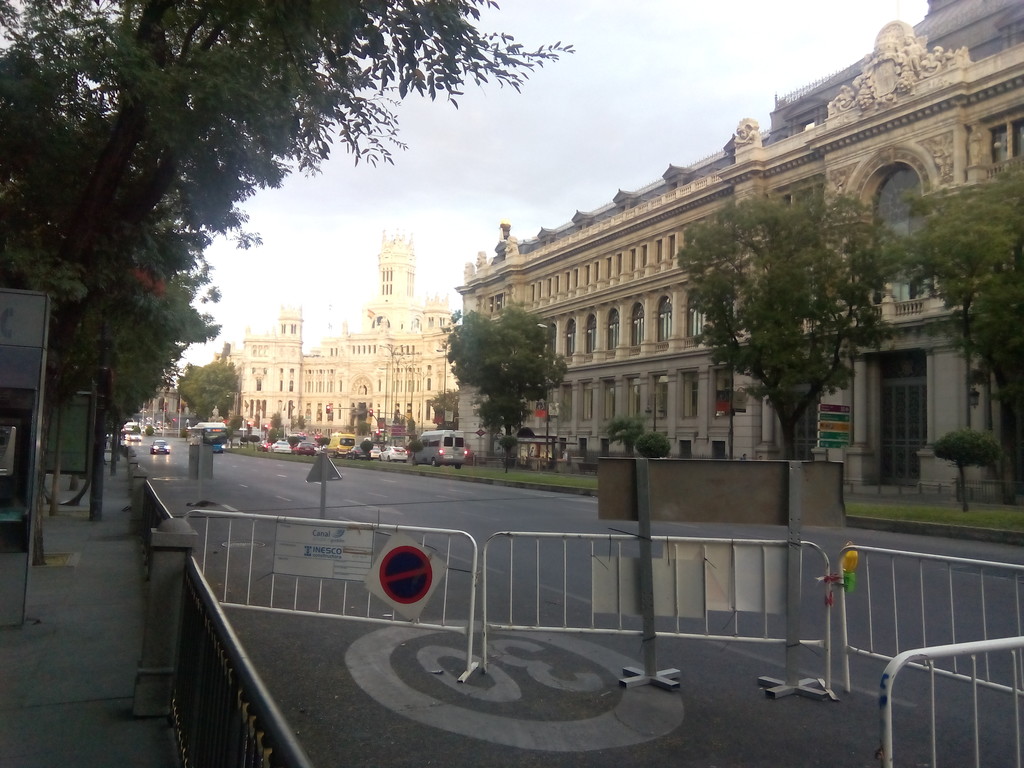One of the things which has always helped me to decide which places I should visit is going to a souvenir shop and looking at the photos on the postcards. In Mexico, I found that the Gran Vía and El Retiro appeared in many of the photos of Madrid, as did the Fuente de Cibeles and the Palacio de Telecomunicaciones. It´s worth pointing out that Plaza de Cibeles consists of the Fuente de Cibeles together with the Palacio de Telecomunicaciones, as well as the roundabout where the public buses stop.
Plaza de Cibeles is a real must-see in Madrid. It´s likely that you´ll pass by it several times without even realising it, since it´s located on one of the main streets in the city: Calle de Alcalá and Calle del Paseo del Prado. Plaza de Cibeles is also very close to the Gran Vía, to the Parque del Retiro and to the Puerta de Alcalá. Another thing which should encourage you to visit the Plaza is its proximity to the Museo del Prado and the Museo Reina Sofía, which are the most important sights nearby, and if you follow the Avenida del Prado you´ll also encounter many other cultural exhibitions which may capture your interest. The Plaza has experienced several name changes over the years: it was once known as Plaza de Madrid and later as Plaza Castelar. Various important buildings can also be found in the vicinity of the Plaza, such as the Palacio de Buenavista (the army headquarters), the Palacio de Linares, the Palacio de Comunicaciones and the Banco de España.

(Palacio de Comunicaciones, in front, the Fuente de Cibeles)
Fuente de Cibeles (´La Cibeles´ to the locals)
This fountain is much older than it looks: installed in 1782, it´s a monument to fresh air which has more than 230 years´ worth of history! Getting a good view of the fountain is difficult, since it´s located in the centre of a very busy roundabout surrounded by motorists, cyclists and buses, making it almost impossible to cross over to the fountain. In addition to this, there is also no pavement or pedestrian zone to allow tourists to take photos close to the fountain. Many tourists resort to taking a photo from a point near to the metro exit Bando de España, as the beautiful architecture of the Palacio de Comunicaciones can then also be captured in the shot.
At the centre of the fountain stands the goddess Cibeles, who symbolises the fertility of the Earth, nature and the animals. For this reason, sculpted marble lions can be seen pulling her carriage. The fountains features many mythological representations, not only through the statue of Cibeles but also through the lions, who represent Hippomenes and Atalanta: two lovers turned into lions by Zeus for committing sacrilege and condemned to pull the goddess´ chariot for evermore.
This fountain was designed by one of the most renowned Spanish architects, Ventura Rodríguez, in honour of whom one of the metro stations in Madrid was named. The original purpose of the fountain´s construction was to enable water to be piped into the city, but in the present day its function is merely decorative.
Palacio de Comunicaciones
This building has much history and has been altered several times, as is the case with many monuments in Madrid. It has been the headquarters for various organizations, for example the Oficina de Correos (the Spanish Post Office, which is now located in the Plaza del Sol) and the Alcaldía de Madrid (the city hall), at a time when both of these up-sized from smaller buildings.
The building is also know as the Palacio de Cibeles or the Palacio de Telecomunicaciones. It´s one of the most striking and visually attractive buildings in the whole city: for me at least, it was one of my favourites, second only to the Palacio Real.
Building finished in 1919, meaning that the Palacio de Comunicaciones is much younger than the antique Fuente de Cibeles and Banco de España building. Before housing the Ayuntamiento de Madrid, the Palace of Cibeles used to be the central office of the Spanish postal service. However, at the start of the 21st century, extension work and remodelling started so that some offices of the Ayuntamiento could be incorporated. Only a few years later, the complete changeover was completed, although to this day a small section of the Spanish postal service still operates in the building. It´s enjoyable to see the numerous old letterboxes inside the building with their destination in the upper parts of the building inscribed on them.
The building´s white façade, which on occasions appears to have a hint of gold, is made of Novelda stone and gives the building a Modernist style, something which can be best appreciated by the finishing touches which can be seen inside.

(The very same Palacio de Comunicaciones, with a hint of gold visible)
Banco de España
Very near to Plaza Cibeles is the Banco de España building, just next to the metro station. Construction began on the Banco de España in 1884, making this building with over a century´s worth of history another unmissable sight here. The building has undergone various extensions and modifications over time, both in terms of its structure and in terms of its name. Created by King Charles III of Spain, whose intention was to create a society based on shares, the building once bore his name as the Banco Nacional de San Carlos.
There is a strange legend which says that if somebody tries to steal gold from the Banco and the alarms sound in the Cámara de Oro (a chamber where the Banco stores its gold), the water from the Fuente de Cibeles will flood the chamber as a means of protection. This is, however, only a legend! Though the Banco de España is a truly beautiful building, the striking Palacio de Comunicaciones next door overshadows it.
One of the things which most appealed to me about this building is the fact that it is available to hire for public events: on October 10th, the Edificio de Cristal del Palacio de Comunicaciones hosted the Madrid Student Welcome Day event, where exchange students from all over the world were welcomed by the mayoress.

(Roof of the Edificio de Cristal)

(Madrid Student Welcome Day event)
The building´s importance is so great that it was declared a Monument of Bien de Interés Cultural in 1993. At the moment, there is a large sign hanging on the façade declaring Madrid´s solidarity with the people of Syria.
Sport celebrations
Many people associate the Fuente de Cibeles with the Real Madrid football team. This is because fans often celebrate the team´s victories here, as well as the victories of the Spanish national team. I found this very curious, as in Mexico the celebrations always occur around the Angel of Independence.
Las Cibeles of Mexico
The first time I saw this fountain, I had the feeling I had seen a similar design somewhere else. Later I discovered that there is an exact copy of the Fuente de Cibeles in Mexico, which can be found near the Glorieta de Insurgentes. This fountain was gifted to Mexico in 1980 and represents the strong ties which exist between Spain and Mexico.
Plaza Cibeles today
Plaza Cibeles continues to be an important place today, since it is a popular meeting place. Near to Plaza Cibeles is Plaza del Sol, a zone where the local people often go out to bars and clubs. Many finish their night out by making their way to Plaza Cibeles, where the night buses, known locally as ´owls´, regularly depart from until the early hours of the morning.

Top tips:
- Visit Plaza de Cibeles during the day as well as at night. The Plaza is lit up spectacularly at night and it will be easier to take a photo.
- Opening hours permitting, go into the Palacio de Comunicaciones and climb up to the terrace to get an amazing panoramic view of the city.
How to get there
Getting to Plaza Cibeles is very easy:
- If you are travelling by metro, take Línea 2 (red) and get off at the station ´Banco de España´.
- If you are travelling by bus, take any of the following lines: N21, N20, 1, 2, 9, 15, 20, 51, 52, 74, 146, N5, N6, N7, N8, 34, N13 o N14.
- Personally I recommend travelling by bike, since this is the best way to get to know the city and you can use the famous BiciMAD service. The hire prices are cheaper than the bus and the metro, and there are also several bike stations in this area. If you get tired, the bikes can also run on electricity, and are rechargeable at the stations.
